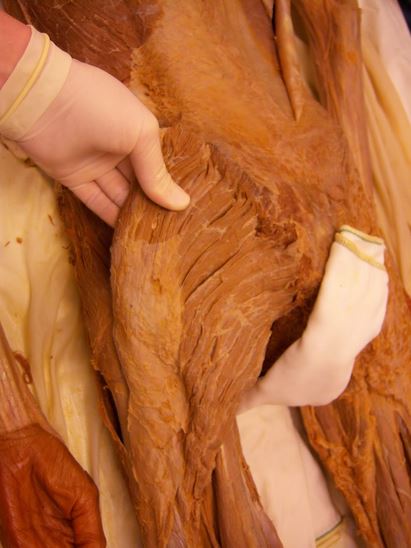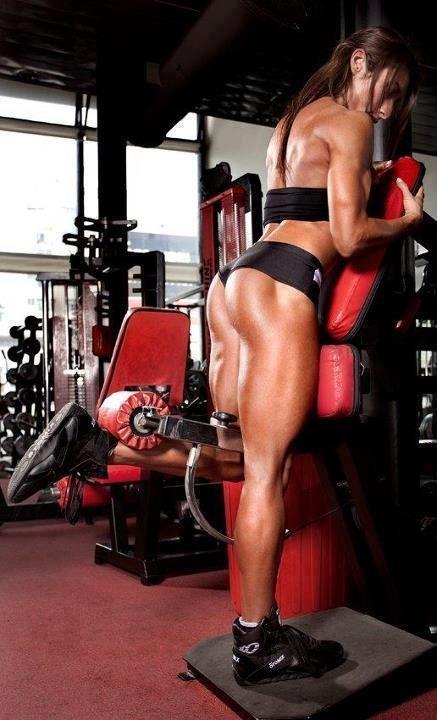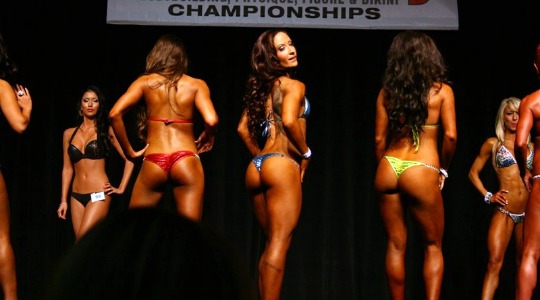Last week I made an appointment with a PhD Anatomy professor to visit his laboratory and examine the muscular anatomy of cadavers. I’ve seen cadavers in the past, but now that I’m much more knowledgeable, I got much more out of the experience. Seeing the glutes in this state really allows you to envision their functional roles and capacities. Here are six glute facts that I’d like to share with you today:
1. The gluteus maximus does its thang through myofascial force transmission
Having actually felt the fiber insertions of multiple cadavers, this is what stood out to me the most. The vast majority of glute fibers insert into fascia. Textbooks say 70-85% but it might be even higher. Only a small percentage insert onto the gluteal tuberosity of the femur. See the pic below – the red insertion portion shows how much of the glute max inserts onto the leg – the rest (blue) inserts into the fascia lata (especially the iliotibal tract).
The fascia lata wraps around the entire leg. When muscles such as the gluteus maximus and tensor fascia lata contract, they “tense” the fascia lata which compresses the entire thigh region, which influences muscular contractile biomechanics. See THIS article – the fascia lata is more than just a stocking. In this manner, the gluteus maximus will influence the biomechanics of the entire leg musculature through myofascial force transmission.
Last year I showed you how the gluteus maximus greatly enhances knee stability during the lunge exercise HERE, through its influence on the tibia via the iliotibial band. The gluteus maximus has far-reaching influences across the body due to its fascial connections.
2. The deep sacral fibers of the gluteus maximus stabilize the sacroiliac joint
Having read THIS article on the deep sacral fibers of the gluteus maximus a couple of years ago, I was on the lookout to see this in the cadavers. The gluteus maximus contains short fibers deep into the muscle that cross the sacroiliac joint (SIJ) and most likely contribute to the stability of the structure (some fibers attach to the sacrotuberous ligament and can influence stability through this route too), thereby preventing low back pain. The SIJ appears to be implicated in approximately 25% of low back pain incidents according to THIS and THIS review, so this is quite important!
3. The gluteus maximus is well-built for hip external rotation
When you examine the fibers of the gluteus maximus, you can envision how they’d be well-suited for hip extension. However, it’s also quite apparent how effective their design is for hip external rotation. My EMG studies show that the gluteus maximus is HIGHLY recruited during band hip rotations and Pallof presses, and other research shows that the gluteus maximus is highly recruited in throwing, swinging, and striking actions in sports. To quote Professor Neumann in Kinesiology of the hip: a focus on muscular actions:
“The gluteus maximus is the most potent external rotator muscle of the hip. This suitably named muscle is the largest muscle of the hip, accounting for about 16% of the total cross-sectional area of all hip musulature. Assuming that the gluteus maximus muscle’s line of force is directed approximately 45° with respect to the frontal plane, maximal-effort activation would theoretically generate 71% of its total force within the horizontal plane (based on the sine or cosine of 45°). All of this force could theoretically be used to generate an external rotation torque.”
Basic trigonometry shows that 71% of the muscle force created by gluteal contraction can translate to external rotation torque! Here’s a good beginner movement for teaching the gluteus maximus of the rear leg to produce hip external rotation torque in order to counteract (stabilize) the hip internal rotation torque induced by the band.
4. The lower gluteus maximus fibers don’t adduct the hip; electromyography (EMG) trumps functional anatomy
I’ve seen dozens of textbooks and articles claiming that the lower fibers of the gluteus maximus produce hip adduction. For example, see HERE, HERE, HERE, HERE, and HERE.
When examining the fibers, it looks like the lower gluteus maximus fibers would indeed aid in adduction. Some of the fibers insert into fascia located near the medial side of the femur, which would make it seem that they’d be capable of producing adduction. However, herein lies the problem with just relying on functional anatomy for knowledge of biomechanics. In order to produce the movement, the lower fibers of the gluteus maximus would need to be activated during adduction movements.
In my experiments, I’ve been unable to detect any lower gluteus maximus activation in all the subjects I’ve tested during adduction maneuvers. Karlsson & Jonsson reported the same findings 48 years ago in 1965. To quote the authors,
“Accordingly the results to not seem to bear out Kopsch’s (1955) hypothesis that the distal portion of the gluteus maximus can act as an adductor of the thigh.”
So it appears that this misconception arose 58 years ago in some German textbook as a hypothesis via examining anatomy. But if theories don’t jive with experimental findings, then they need to be dropped.
5. Gluteus maximus moment arms in the literature are highly underestimated
A moment arm is an measurement of a muscle’s leverage (in this case it would be deemed a muscle moment arm or an internal moment arm). This is important data in biomechanics, as it allows one to estimate a muscle’s torque capacity. To quote Channon et al.,
“Muscles facilitate skeletal movement via the production of a torque or moment about a joint. The magnitude of the moment produced depends on both the force of muscular contraction and the size of the moment arm used to rotate the joint. Hence, larger muscle moment arms generate larger joint torques and forces at the point of application.”
When researchers measure the moment arms of muscles, they utilize different techniques. Sometimes they use cadavers, often of frail or older individuals (cadavers are dried up and flat). Sometimes they use CT scans, but the subjects are typically positioned supine which flattens out their glutes.
Check out the picture below. Look how close the glute max is going to be positioned to the hip in the saggital plane. This will yield a small moment arm measurement.
The gluteus maximus moment arm of an upright, athletic individual will be greater, and this will be even more pronounced when the gluteus maximus is contracting. Check out the picture below – the gluteus maximus moment arm is going to be markedly larger in this situation.
There is currently no research examining gluteus maximus torque capabilities in athletic subjects during athletic endeavors. For example, I bet that sprinters’ glutei maximi during sprinting or powerlifters’ glutei maximi during hip thrusting (or simply during MVC’s) would yield considerably greater gluteus maximus moment arm measurements, and the PCSA is affected too due to changes in pennation angle during muscle contractions.
If this is the case, and I’m pretty sure it is, then the strength and power potential of the gluteus maximus is underestimated in the literature. Sure you could say the same for other muscles, but I suspect that it’s underestimated to a greater degree in the gluteus maximus compared to other muscles.
6. Genetics Highly Influences Glute Size
The anatomy professor insisted that I inspect the smallest gluteus maximus specimen (belonging to a cadaver of a frail, elderly individual), as well as the largest gluteus maximus specimen (belonging to a middle-aged mammoth of a man). A few months ago I wrote about glute genetics HERE and reported that there is an inter-individual variation of 500% in terms of gluteus maximus volume, meaning that some folks have 5X the glute size of others. In inspecting the specimens, this became apparent. For the unlucky individuals with poor glute genetics, luckily they now have Strong Curves and Strong by Bret for some guidance and hope!














Who’s the girl doing standing leg curls in the pic above? :: bites knuckle ::
I don’t know who she is Brad…sorry mate! I’d like to know too.
Paula Frega
Good call Steve!
Hi Bret,
this is an excellent article, as usual. The only thing that I’d like to say is that it’s a shame to see such a great article “slightly ruined” (very slightly, I admit) by spelling mistakes: “it’s” instead of “its”. Your blogposts are too good to contain these sorts of errors. 🙂
Keep up the great work and keep strengthening glutes all over the world. (I am a proud Get Glutes member, by the way).
Hi Sarah! Glad you like GG! I’d like to promise you that future blogposts won’t contain errors, but I don’t think that’s realistic. I’m a one-man army here and don’t have any editors. And I suck at editing my own work. I skip right over it! In fact I just tried to find the error(s) you mentioned and didn’t find any haha! So I will try to be better at proof-reading, as I know what you’re talking about…it’s a turn-off to see such errors. But it’s rare to find a strength coach who knows the practical side, understands the science, and can also write well. There are only a few guys in the field who fit all three methinks. Not making excuses though, and if you see errors definitely point them out to me and I’ll fix them. Thanks, BC
Deal, Bret. 🙂
So, last paragraph of Chapter 1 (The gluteus maximus does its thang….), second line: “….through its (not “it’s”) influence on the tibia….”.
I switched “it’s” to “its” but kept “thang” and “ain’t”! Meatheads are allowed more wiggle-room in this regard 😉
LOL. If you’re a meathead, you’re a very smart one. 🙂
Sounds very smart, but how does all this knowledge help us dummies in the gym / increase fitness??
thanks
Wickets – this was a scientific post. I have a practical post coming out later this week that you’ll enjoy. It’s ideal to understand the science which better enables you to train optimally, but this comes in time. Initially you just need to know the exercises, the programs, and proper form.
Thanks….I just finished reading the ‘practical’ version……very much appreciated
Bret, any EMG studies done by yourself on musculature of dors. Flexion and plantar flexion?
Calves here: http://www.t-nation.com/testosterone-magazine-623#inside-the-muscles
No tibialis anterior though.
Hi Bret, I am a huge fan and have a supremely challenging butt. The very fact that you go the extra mile and examine cadavers makes me even more secure in following your advice. As a soon-to-be personal fitness trainer and boot camp instructor, let alone with plans to compete in figure in the coming year, I am super excited to put your exercises and philosophy into practice. And if you ever want anyone to edit your posts for grammatical errors, I’d be happy to. I’m a published novelist and writing workshop facilitator as well. One day I’d love to hire you to help me with my glutes if I can’t get the job done by following your online advice. Thank you for another super informative, inspirational post! And I am now a huge fan of Paula Frega’s.
Elise – focus on your hip thrust. Your goal is 225 lbs for 10 reps. Take your time and build up but know that you can achieve this. When you do this, you’ll likely be very pleased with your results.
Thanks Bret, I’ll do that! Much appreciated.
A scientific post for sure. You give tons of practical information – geekier posts are always nice to read here; especially that you link out to further explanations.
Glad someone appreciates that!!! Thanks Elie.
Great Job sr!
Now lets go to the lab (gym) and make some experiments.
Yes sir!
Bret, Great point about the myofascial force transmission. Just finished reading an article that demonstrated the myofascial force transmission from the latissimus to the contralateral gluteus max through the thoracolumbar fascia. I’m trying to figure out a way to do a lat pull while hip thrusting, and see how that feels.
Hi Andy, I suspect that this would compromise the effect of each exercise. To tease it out:
If you follow the logic of the thoracolumbar fascia interrupting the same sheath of musculature, (and it is a persuasive case), then you are effectively now looking at a biarticulate muscle crossing two joints, really more like four joints when you consider the effects up and down the kinetic chain due to the fascia!
Thus, trying to work both sides together is now akin to the active insufficiency of say, trying to use the rectus femoris to both flex the hip and extend the knee simultaneously. Biarticulate muscles are just not that great at performing both their functions at the same time.
I have a theory that biarticulate muscles’ more dominant function is from the proximal attachment out. So the RF is really more of a hip flexor than a knee extender. And the long head of the triceps is more of a shoulder extender than an elbow extender. (Think how heavy ass dumbbell pullovers seem to target the long tricep head better than behind the neck tricep extensions.)
Thus I think you are better off using the lat to stabilize the torso for the glute, and the glute to stabilize the pelvis for the lat, and this frees up the opposite side musculature to fire more explosively.
But if you discover a method to hit both at the same time, please post the video. I want to try it!
Take anabolic steroids and do squats if you want bigger glute muscles.
Why overcomplicate things (and examine dead bodies ffs)? Jesus. What did anyone learn after reading all that?? Not a damn thing.
I gave better glute-building tips in one sentence then you did in all your article.
And before I get some stupid passive-agressive comment off some stupid delusional woman (STANDARD); Do you think Ronnie Coleman knew/researched all that crap to build the most muscular ass of all time? No. He just took a crapload of PEDs and done a crapload of squats. One more thing; ALL your muscular “female” idols who inspire you to lift, take PEDs, including the 3 he/she’s in the (individual) pics.
Oh you felt like saying something else? Well here’s my answer: Yes, Carmelita J and Jamie E are drug cheats and drug tests are easily beaten.
HTFH
Come on dude! Why would you encourage women to use anabolic steroids when they can have permanent side-effects? Women should avoid anabolic steroids and do a variety of glute exercises including hip thrusts, squats, deads, etc.
Great article Brett. As usual.
What are your thoughts this theory in relation to Track cycling sprinting?
I find the ability to effectively fire the glutes during the pedaling action is directly impacted by my ability to activate my multifidis to aid in anterior pelvic tilt.
Going off this where you mention in one of your other articles where the deep glutes are in continuum with the multifidis this makes more sense to me know.
Other than walking lunges and single leg hip thrusts. Are there any other exercises you would recommend to firstly improve stability in that area then improving dynamic strength, power and speed.
Again Thanks
Mick
Hi Bret. Do you know through dissections or EMG studies whether the gluteus medius (anterior and/or posterior portions) has any effect on the iliotibial tract?
Hi Dan, great question.
Here’s a study pertaining to anatomy: http://www.ncbi.nlm.nih.gov/pubmed/24139012
And here’s one pertaining to biomechanics: http://www.tihcij.com/Articles/Etiology-Treatment-and-Prevention-of-ITB-Syndrome-A-Literature-Review.aspx?id=0000406
Hi sir ,
i want to know that great arm rotation is depends up on the glutes contraction , how its interlink
carmelita jeter is a known doper. not that you are wrong but why not show natural looking athletes than women(or men) who are on testosterone / HGH / other designer compounds